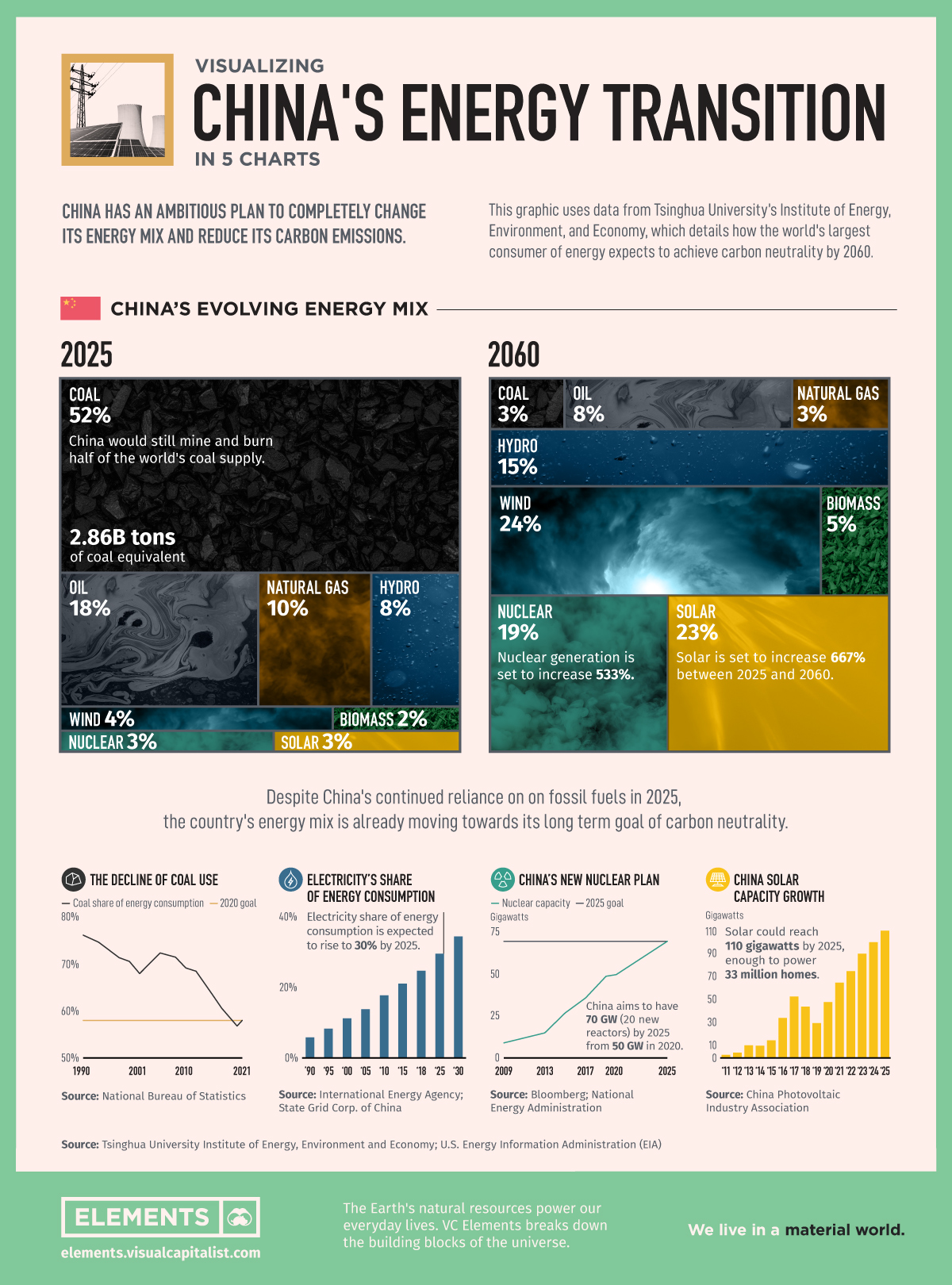Visualizing China’s Energy Transition in 5 Charts
![]() Subscribe to the Elements free mailing list for more like this
Subscribe to the Elements free mailing list for more like this
 |
Visualizing China’s Energy Transition in 5 Charts
By Bruno Venditti- In September 2020, China’s President Xi Jinping announced the steps his nation would take to reach carbon neutrality by 2060 via videolink before the United Nations Assembly in New York.
This infographic takes a look at what this ambitious plan for China’s energy would look like and what efforts are underway towards this goal.
China’s Ambitious Plan
A carbon-neutral China requires changing the entire economy over the next 40 years, a change the IEA compares to the ambition of the reforms that industrialized the country’s economy in the first place.
China is the world’s largest consumer of electricity, well ahead of the second place consumer, the United States. Currently, 80% of China’s energy comes from fossil fuels, but this plan envisions only 14% coming from coal, oil, and natural gas in 2060.
| Energy Source | 2025 | 2060 | % Change |
|---|---|---|---|
| Coal | 52% | 3% | -94% |
| Oil | 18% | 8% | -56% |
| Natural Gas | 10% | 3% | -70% |
| Wind | 4% | 24% | +500% |
| Nuclear | 3% | 19% | +533% |
| Biomass | 2% | 5% | +150% |
| Solar | 3% | 23% | +667% |
| Hydro | 8% | 15% | +88% |
Source: Tsinghua University Institute of Energy, Environment and Economy; U.S. EIA
According to the Carbon Brief, China’s 14th five-year plan appears to enshrine Xi’s goal. This plan outlines a general and non specific list of projects for a new energy system. It includes the construction of eight large-scale clean energy centers, coastal nuclear power, electricity transmission routes, power system flexibility, oil-and-gas transportation, and storage capacity.
Progress Towards Renewables?
While the goal seems far off in the future, China is on a trajectory towards reducing the carbon emissions of its electricity grid with declining coal usage, increased nuclear, and increased solar power capacity.
According to ChinaPower, coal fueled the rise of China with the country using 144 million tonnes of oil equivalent “Mtoe” in 1965, peaking at 1,969 Mtoe in 2013. However, its share as part of the country’s total energy mix has been declining since the 1990s from ~77% to just under ~60%.
Another trend in China’s energy transition will be the greater consumption of energy as electricity. As China urbanized, its cities expanded creating greater demand for electricity in homes, businesses, and everyday life. This trend is set to continue and approach 40% of total energy consumed by 2030 up from ~5% in 1990.
Under the new plan, by 2060, China is set to have 42% of its energy coming from solar and nuclear while in 2025 it is only expected to be 6%. China has been adding nuclear and solar capacity and expects to add the equivalent of 20 new reactors by 2025 and enough solar power for 33 million homes (110GW).
Changing the energy mix away from fossil fuels, while ushering in a new economic model is no small task.
Up to the Task?
China is the world’s factory and has relatively young industrial infrastructure with fleets of coal plants, steel mills, and cement factories with plenty of life left.
However, China also is the biggest investor in low-carbon energy sources, has access to massive technological talent, and holds a strong central government to guide the transition.
The direction China takes will have the greatest impact on the health of the planet and provide guidance for other countries looking to change their energy mixes, for better or for worse.
The world is watching…even if it’s by videolink.

